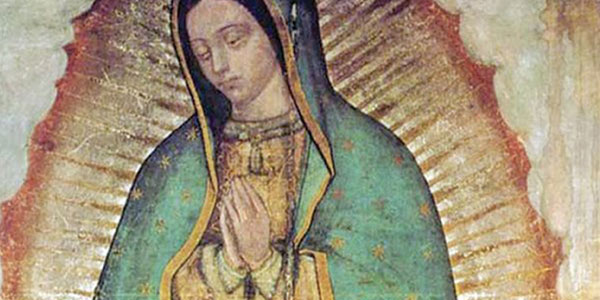
Nuestra Señora de Guadalupe (NSG) es una imagen sagrada y una narración que se refleja a través del tiempo y el espacio, y a través del corazón y la mente del creyente y del incrédulo por igual. Originalmente localizada en el siglo XVI en México central, ha llegado a tomar un profundo significado teológico y cultural dentro del catolicismo de México y más allá. Por supuesto, en estos artículos queremos saber: ¿Se apareció la Virgen Maria a un nativo llamado Juan Diego y trasladó su imagen sobre la tilma de Juan Diego? No importa si lo hizo o no, no altera el hecho de que la Iglesia mexicana ha contribuido a la tradición histórico cristiana de la iconografía sagrada y la devoción a una imagen de gran belleza y significado.
¿La imagen, ahora en Ciudad de México, ha sido examinada científicamente? Algunos dicen que sí, otros que no.
“No soy sólo una persona religiosa, también soy un científico, un químico, y algunas de las pruebas que tenemos no son fáciles de explicar “, dijo el monseñor Pedro Rivera Díaz a PBS” Religion & Ethics Newsweekly “en 2014.
Según el Hermano. Thomas Mary Senott en La Tilma de Guadalupe: Un análisis científico publicado en el sitio web de The Miracle Hunter, Phillip Serna Callahan, un biofísico de la Universidad de Florida, estudió y fotografió con infrarrojos la imagen.
El Hermano Thomas dice que Callahan encontró la figura original “inexplicable” y que dijo: “En términos de este estudio de infrarrojos, no hay manera de explicar ni el tipo de luminosidad del color ni el brillo de los pigmentos, a lo largo de los siglos”.
Sin embargo, Joe Nickell, Ph.D no está de acuerdo. “En realidad, las fotografías infrarrojas muestran que las manos han sido modificadas, y la fotografía en primer plano muestra que el pigmento se ha aplicado…” dice en “Milagrosa” Imagen de Guadalupe publicada en el sitio web del Comité de Investigación Escéptica. Nickell dice también que la revista Proceso de México publicó un “estudio secreto” realizado por José Sol Rosales en 1982 un «experto en restauración de arte». Según Nickell, «Rosales concluyó que la imagen no se originó sobrenaturalmente, sino que fue obra de un artista que utilizó los materiales y las técnicas empleadas en el siglo XVI».
Sin embargo, el P. Stafford Poole, CM, dice en su monografía 2006 Las controversias de la Guadalupana, «Aunque a veces se afirma que la imagen ha sido sometida a examen científico, no es cierto… nada en los tiempos modernos comparable a los exámenes de la Sabana Santa de Turin. “
En cuanto a la existencia de Juan Diego, eso también es debatido.
“Hubo una acalorada polémica”, dijo a PBS Bernardo Barranco, del Centro de Estudios Religiosos de México. “Ellos consultaron historias, bibliografías, historiadores, académicos, y al final decidieron dejarlo a la fe. Históricamente no se puede probar la inexistencia de Juan Diego, y los religiosos no pueden probar su existencia”.
Y así va, el controvertido y complejo estudio de Nuestra Señora de Guadalupe.
Al final, el significado duradero de la historia y la imagen de Nuestra Señora de Guadalupe puede no ser, si realmente apareció y trasladó su imagen a la tilma de Juan Diego, sino más bien si la persona en busca de lo divino, cree que algo -o alguien- Desde lo celestial ha grabado un relato y plasmado una imagen sobre su propio corazón y vida.
__________________________________________________________________________________________________________
Our Lady of Guadalupe: Myth or Fact? III
By Nicholas Peterson
Our Lady of Guadalupe (OLG) is a sacred image and narrative that echoes across time and place and through the hearts and minds of believer and unbeliever alike. Originally localized to sixteenth century central Mexico, she has come to take on deep theological and cultural significance within Mexican Catholicism, Mexico, and beyond. Of course, in these articles we want to know: Did the Virgin Mary really appear to a native named Juan Diego and transpose an image of herself upon his tilma? Whether she did or not, however, does not alter the fact that the Mexican Church has contributed to the historical Christian tradition of sacred iconography and devotion an image of great beauty and significance.
Has the image, now in Mexico City, been examined scientifically? Some say yes, others no.
“I’m not only a religious person. I’m also a scientist, a chemist, and some of the evidence we have is not easy to explain away,” Monsignor Pedro Rivera Diaz told PBS “Religion & Ethics Newsweekly” in 2014.
According to Br. Thomas Mary Senott in The Tilma of Guadalupe: A Scientific Analysis posted on The Miracle Hunter website, Dr. Phillip Serna Callahan, a biophysicist at the University of Florida, studied and photographed the image.
Br. Thomas says that Callahan found the original figure “inexplicable,” and that Callahan said: “In terms of this infrared study, there is no way to explain either the kind of color luminosity and brightness of pigments over the centuries.”
However, Joe Nickell, Ph.D disagrees. “Actually, infrared photographs show that the hands have been modified, and close-up photography shows that pigment has been applied…” he says in “Miraculous” Image of Guadalupe posted on the Committee for Skeptical Inquiry’s website. Nickell also says that Mexico’s Proceso published a “secret study” done in 1982 by José Sol Rosales an “art restoration expert.” According to Nickell, “Rosales concluded that the image did not originate supernaturally but was instead the work of an artist who used the materials and methods of the sixteenth century.”
Yet Fr. Stafford Poole, C.M., says in his 2006 monograph The Guadalupan Controversies, “Though it is sometimes asserted that the image has been subjected to scientific examination, that is not true…nothing in modern times comparable to that of the Shroud of Turin.”
As for Juan Diego’s existence, that is also debated.
“There was a heated debate,” Bernardo Barranco of the Center for Religious Studies of Mexico told PBS. “They consulted stories, bibliographies, historians, academics, and at the end they decided to leave it up to faith. Historically they can’t prove the nonexistence of Juan Diego, and the religious can’t prove his existence.”
And so goes the engaging and complex study of Our Lady of Guadalupe.
In the end, the lasting significance of the story and image of Our Lady of Guadalupe may not be whether she really appeared and transposed her image to Juan Diego’s tilma but, rather, if the individual person seeking the divine believes that something—or someone— from the divine has etched a narrative and transposed an image upon their own heart and life.










